Contents on this page:
Deer Resistant Plants~Native Gardening Basics~Importance of Keeping Leaves
Deer Resistant Plants
We’ve been asked a few times about deer-resistant plants, and we’ve done some research and have compiled the below list sorted by sun requirements.To assemble the document we cross-referenced from different sources that report these native plants as being deer resistant. Sources include personal experiences from prairie restorationists, Prairie Moon Nursery, Lady Bird Johnson Wildflower Centers Special Collections pages: (http://www.wildflower.org/collections/collection.php?collection=deer), Morton Arboretum: (http://m.extension.illinois.edu/wildlife/files/plants_deer_avoid.pdf)A very helpful page is http://www.wildoneslansing.org/uploads/9/8/9/0/9890611/deer_resistant_native_plants_for_mid-michigan_5_7_14.pdf
Unless noted, soil conditions are assumed to be typical garden soil here in the Chicago area–clay/loam which tends to hold onto moisture but still drain. Plants in the full sun group can generally take part sun too, and those in the shade group can likewise take part sun. To determine correct plants for your site, further research should be done. Many of our sources warn that hungry deer in the spring are less discriminate about their meals then. Just as a note, not all deer resistant plants are rabbit resistant.
Let us know if you have a plant that deer seem to avoid in your garden, and it’s not listed here. We’ll add it.
Full Sun Plants
| Plant name | Bloom time | Height | Special notes |
| Monarda species | Summer | 3-4 | Hummingbird/Bumblebees |
| Rudbeckia spp | Summer/Fall | 2-3 depending on species | Butterfly host plant |
| Asclepias spp | Summer | 2-4 depending on species | Monarchs |
| Solidago spp | Fall | 2-5 depending on species | Provides for many insects |
| Coreopsis spp | Summer | 2 | |
| Filependula rubra | Summer | 4′ with spires | |
| Echinacea spp | Summer | 3-4 | Butterfly host plant |
| Eupatorium spp | Summer/Fall | 3-5 depending on species | |
| Artemesia | Fall–flowers generally inconsequential–foliage is silvery gray | 3 | Butterfly host plant |
| Allium spp | Summer | 12 | Some species provide early nectar |
| Liatris spp | Summer | 2-5 depending on species | |
| Ruellia | Summer | 1-2′ | May feed Buckeye butterfly caterpillar |
| Amorpha spp | Summer | 2-3 | Butterfly host plant |
| Asters spp | Fall | varies; you can prune | Butterfly host plant |
| Eryngium yuccifolium | Summer | 3-4′ | |
| Vernonia spp | Summer/Early Fall | 4-5 | |
| Parthenium integrifolium | Summer (long bloom time!) | 2-3′ | Great pollinator plant |
| Agastache spp | Summer 3-4 | 3′-4′ depends on species | Great pollinator plant; seeds for birds |
| Baptisia spp | Spring | 1-3 depending on species | Butterfly host plant |
| Senna hebecarpa | Summer | 45 can be pruned | Butterfly host and great pollinator plant |
| Pycantheum spp | Summer | 2-3 | Great pollinator plants |
| Euphorbia corollata | Summer | 2-3 | |
| Hypericum spp | Summer | 2-4 tall depending on species | Amazing pollinator plants |
| Dalea purpurea | Summer | 2 |
Part Sun
| Plant name | Bloom time | Height | Special Notes |
| Anemone candanesis(grows in shade too) | Late spring | 1 | adaptable, aggressive, good for groundcover |
| Shooting Star | Spring | 1-2 | |
| Gentian spp | Fall | 2′ | |
| Solidago spp | Fall | 2-5′ depends on species | |
| Phlox divaricata | Spring/Summer | 1′ | |
| Helianthus strumosus | Summer/Fall | 3-5 | |
| Penstemon digitalis | Summer | 3′ | |
| Eupatorium maculatum | Summer | 3-4′ | |
| Zizea aurea | Spring | 2 | Black swallowtail host plant |
| Ceanothus americanus | Summer | 3 | Hosts azure butterflies, duskywing |
| Asters spp | Summer-Fall | varies | Pearl Crescent butterfly |
| Campanula spp | Summer | 2′ | |
| Verbena spp | Summer | 4 | |
| Chamaecrista fasciculata | Summer | 2 | Great pollinator plant; hosts sulphur butterflies |
| Lobelia sp | Summer | 3-4 | Hummingbirds |
| Helenium autumnale | Fall | 3-4 | |
| Physostygia virginia | Summer | 3-4 | Can be aggressive, hummingbirds |
| Iris virginica | Spring 3 | 2-3′ | Moist soil |
| Pedicularis canadensis | Spring | 1 |
Shade
| Plant name | Bloom time | Height | Soil |
| Sanguinaria canadensis | Spring | max 12 | |
| Tiarella cordifolia | Spring | | |
| Solidago (Elm-leaved Goldenrod, Zig-zag Goldenrod are a couple examples that will take shade) | Fall | varies | |
| Polemonium reptans | Spring | 1-2′ | |
| Asters spp | varies | ||
| Actea spp | Spring flowers and berries in fall | 1-3′ | |
| Cimicfuga racemosa | Summer | 5 when in bloom | |
| Asarum canadense | Spring, interesting flowers | Ground cover | |
| Arisaema triphyllum | Spring, interesting flower and berries late summer | 1-2 | |
| Geranium maculatum (can handle range of light conditions) | Spring | 1-2 |
Native Gardening Basics
by Marni Curtis for West Cook Wild Ones
There are many ways to start using native plants in your garden. You can start to incorporate native plants into your existing landscape or – you can start completely from scratch.
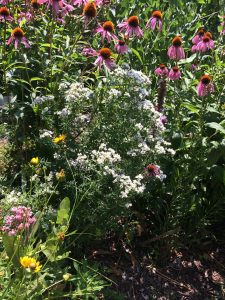
First, make an assessment of the environmental conditions (shady or sunny, drainage, soil types, irrigation, etc.). Also, make an inventory of your existing plants.
It is also helpful when creating a naturalistic landscape design to consider the associations found in specific plant communities (a prairie, wetland or forest). You may also want to visit some local natural areas to observe these associations first-hand.
Planning and planting a native garden does not have to be done all at once. It can be installed in phases as your budget and time allows.
Soil Preparation
If weeds are a big problem, you may want to consider not only hand-pulling, but maybe even covering them with a sheet of clear plastic for several months a process known as solarization. Other methods to kill weeds are pouring boiling water or vinegar on them. By eliminating weeds first, as much as possible, before planting, it will be much easier than trying to control them in a newly planted site. Just as anote, methods that involve solarization, vinegar, boiling water may also kill the beneficial life in the soil. If you use those methods, allow some time for pH of the soil to return to normal and consider adding good compost or healthy soil from other areas of your garden to help repopulate your soil with beneficial microorganisms.
Native plants usually do not require fertilizer. Many thrive in poor soil and applying fertilizer could chemically burn them, or stimulate either lush or spindly, weak foliage growth with few flowers.

If you are planning to replace your lawn with a prairie type garden, you may want to consider the using the sheet mulching method water your lawn and then cover it with newspaper or cardboard. Water the newspaper or cardboard and cover with mulch. On top of the cardboard you can put grass clippings or fall leaves on, and then cover with mulch. Allow a month or two before planting to make sure you have won the battle. Fall is a great time to do sheet mulching.
Plant Selection and Plants
Choose species based on the soil, light, and water conditions of your site and for the size, shape, texture, and color you desire.
Suggested Prairie Plants (full sun):
Spring:
Spiderwort, Golden Alexanders, Prairie Smoke, Prairie Phlox, Cream Prairie Indigo
Summer:
Purple Prairie Clover, Purple Coneflower, Black-eyed Susan, Butterflyweed, Culvers Root
Fall:
New England Aster, Smooth Blue Aster, Stiff Goldenrod, Showy Goldenrod
Grasses:
Little bluestem, Big Bluestem, Prairie Dropseed, Indian grass, Switch Grass
Suggested Woodland Plants (shade):
Spring:
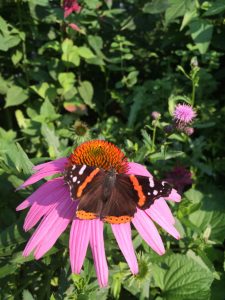
Wild geranium, Virginia bluebells, wild columbine, celadine poppy
Ferns:
Marginal shield fern, ostrich fern, Christmas fern
Groundcovers:
Wild ginger, May apple, Allegheny foam flower
Three-Season Plants:
Solomons seal, Solomons plume, white baneberry
Fall:
Shorts aster, large-leaf aster, elm-leaved goldenrod, zig-zag goldenrod
Shrubs:
Hazelnut, witch hazel, arrowwood viburnum, pagoda dogwood
Maintaining Your Landscape
Your native plants will need time to become established. The critical period for watering and weeding is two to three weeks after planting or longer if you are planting in warm, dry seasons. If you are planting trees or shrubs, apply a four to six-inch layer of organic mulch around them (but, not touching the main stem) and a one-inch or less mulch layer for perennials. Mulch can help control weeds, reduce temperature fluctuations, help retain moisture and give a finished look to the landscape.
Enjoy the butterflies and birds that visit. Each year add more native plants. Make more prairie and/or woodland spaces. Educate your neighborhood by example! Once you get started, it becomes easier and easier every year to maintain your property/grounds — less mowing and watering; more wildlife and soil improvement.
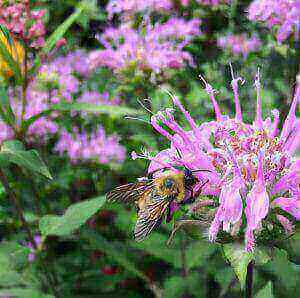
What’s in a Leaf Pile?
Many beneficial (and beautiful) insect overwinter in our yards. For instance, the Katydid (important food source for birds during late summer) and Preying Mantis overwinter as eggs attached to twigs, stems, and/or leaves. Ladybugs and Lacewings also spend the winter in our gardens. Native bees find winter homes in soil, plants (stems, under grasses), and leaves. Cutting down a garden and removing all litter in the fall reduces these insect populations, most of which are beneficial. According to the University of Maine, 97% of insects in our yards are beneficial (http://umaine.edu/publications/7150e/). Furthermore, many of these insects are critical food sources for migrating birds and for birds raising their young. 95% of birds feed insects to their young even if the adults eat seeds (Tallamy, Bringing Nature Home). Keeping your healthy leaves either as garden mulch or in piles under trees or shrubs will offer you many benefits over the year:
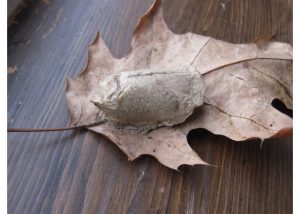
feed microrganisms which feed your plants (there are complicated relationships under ground); these organisms in turn clean the water and air and improve soil texture. Many woodland/savannah plants require the leaf layer for the resulting rich humus.
keep water levels stable–absorbs more water, drains better, and keeps moisture available to your plants through drought(lots of seeming contradictions but it’s true)
mulch your garden through the winter
provide cover for overwintering bees, butterflies, moths, and other beneficial insects
provide food for those above creatures provides food for birds
reduce the need to buy bags of mulch or compost (and then the associated pollution and costs connected to those items (plastic bags, transportation))
reduce pressure on finances and resources of the village; money saved there could go to more positive use
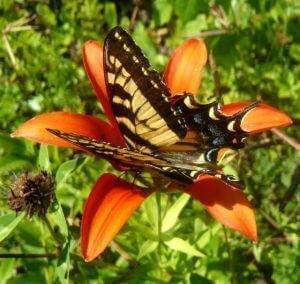
For further reading: Life in the Soil: A Guide for Naturalist and Gardeners, James B. Nardi.
Teaming with Microbes: The Organic Gardener’s Guide to the Soil Food Web, Revised Edition, Lowenfels and Lewis
